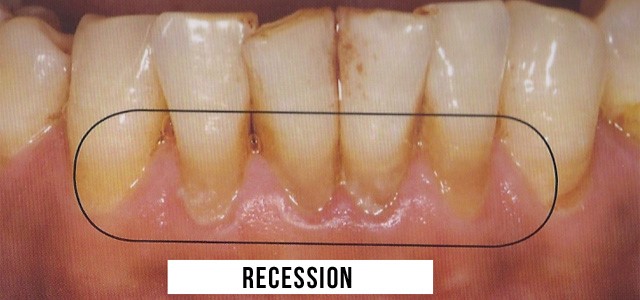Gum recession

Gum recession is a phenomenon where the gums recede or pull away from the teeth. This leaves the root surface exposed. Since the root surface does not have a hard enamel covering as the crown (top) of the tooth does, the root may become sensitive to hot and cold temperatures, air, sour or spicy foods and sweets. When you can see the roots of the teeth, this is recession already in progress.
Causes of Gum Recession
- Gum disease.
- Aggressive toothbrushing.
- Smoking/tobacco use.
- Tooth misalignment.
When gum disease is present, there is an infection causing inflammation, redness and destruction of the fibers that attach the gums to the teeth. A dentist can measure how far the disease has progressed with an instrument called a probe. This device can measure the loss in millimeters. More than 3 millimeters suggests that inflammation and gum disease has begun. Gums will recede if this condition is not properly treated. Using a medium or hard-bristled toothbrush and aggressively brushing can cause recession, and smoking can also create trauma and is an irritant to the gums, which can in turn lead to the same results. Crowded teeth increase the risk, and excess force placed on the teeth can play a role in the loss of gum tissue. Clenching can cause abrasion of the tooth enamel, which can contribute to loss of gum and lead to recession. Finally, with the use of orthodontia, teeth that are moved too rapidly can cause bone loss followed by gum recession around those teeth.
Signs and Symptoms of Tooth Recession
- Exposed root surfaces.
- Redness and swelling of the gums.
- Tooth appearing longer than normal.
The key to preventing recession is to treat early signs of gum disease. Keeping gums healthy will prevent infections from destroying the gums and exposing root surfaces. Using a soft-bristled toothbrush and light pressure to avoid trauma to the gums and to eliminate recession is also another preventive measure. Giving up tobacco is imperative because tobacco use causes direct tissue irritation and can exacerbate gum recession. The wearing of a nightguard will help with grinding, which can reduce the risks of tooth recession as well. Following proper oral care and having twice-per-year dental hygiene visits can also assure that gum disease will not lead to recession. Limit sugar and acidic foods, which can allow bacteria to thrive, cause tooth recession to progress and cause sensitivity and root decay.
Gum recession is a common dental problem that occurs gradually. The first sign is usually tooth sensitivity, or you may notice that a tooth looks longer than normal. Sometimes a notch can be felt near the gumline too. According to the American Academy of Periodontology, if excessive recession is present, a procedure known as a “gum graft surgery” must be performed by a dental specialist known as a periodontist. This involves repositioning gum tissue from the palate or another source to cover the recession on the tooth surface. Tooth recession is a progressive condition. Your dentist may recommend using a desensitizing toothpaste to help with tooth sensitivity. Generally speaking, good dental hygiene is your best defense against oral health problems, including gum recession.
